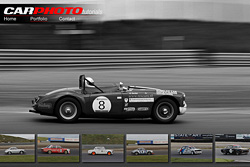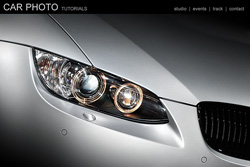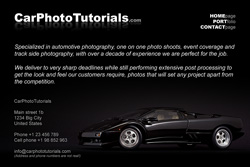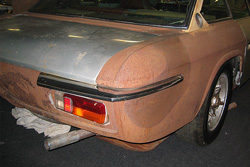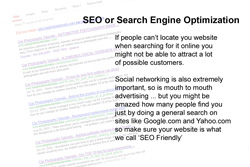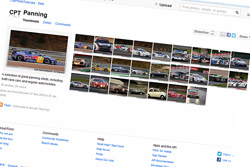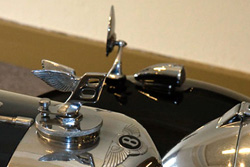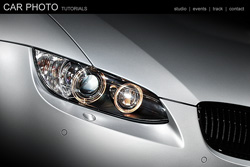PHOTOGRAPHERS NEED A WEBSITE AND A PERSONAL EMAIL ADDRESS

Canon EOS5D Mark II - Canon EF24-105mm f/4.0 L IS - 28mm 1/60 sec f5.6 ISO640
Basic level tutorial by Mark
I have seen it way too many times, some of the best car photographers out there that are just getting started still use a general e-mail address to attract much needed business. Let me tell you something people: stop using a Gmail, Yahoo or other common e-mail service once you think about going professional ... it just doesn't convey the impression to your potential customers you are looking for.
You want to profile yourself as an aspiring new automotive photographer and bring in the big bucks, and that requires you to take your work to the next level ... get your own website and corresponding e-mail address, there is something about a photographer having his own online presence and a personal e-mail that just looks so much more professional than john_smith@gmail.com ... trust me on this one.
First things first ... get your own domain
Life as a car photographer just doesn't get easier over time, first you have to make sure you are better than the competition, especially since most of the competition these days tend to undercut prices or even work for free, so you have to offer something extra to get the job ... and now you have to decide on a name for your online presence.
My 2ct on this: do not use your own name to register a domain, it might sound cool to have www.john_smith.com but you'll have to think into the future on this. Say at a certain point you are able to sell your business for a nice price, you would be really heartbroken to see than .com go, or in the future you stop photographing and take a different path in life ... you will not be able to take that .com with you as it is linked to your 'old' life.
So if you want to have your given name as a domain you should use it for personal stuff, sharing vacation photos and stuff like that, but do not use it for your car photography business, try to find a nice company name (as you will have to register your company and get a VAT number anyway) and register that one as the domain to go online.
1 The .com dilemma
Most of the time you will be looking at registering a '.com' domain for your photography business, problem is that with the abundance of websites online these days it might be serious struggle to find a name for your company that is still available in .com form.
But there might be a solution, if you are not located in the United States of America you can also register a local domain like .co.uk in the United Kingdom, or .nl in the Netherlands, .fr for France ... and so on. Naturally a .com might be more interesting of you tend to work globally, but also keep in mind having a .co.uk domain when you are located in the UK will also help your visibility in localized search engines.
When looking for a domain name you also have to keep in mind the number of characters and possible spelling issues, something like www.my_car_photography_online_portfolio.com might still be available for registration, but there is a simple reason for it ... this is way too long, and potential customers can easily make an error typing this in, also don't fool people with domains that resemble popular ones like www.yahoo.com, www.google.com or www.youtube.com ... that is just not done.
2. The e-mail address
Once you have your very own domain registered the first hurdle has been taken, now comes the second one ... your e-mail address. The usual ones are admin@mydomain.com or info@mydomain.com and that is just fine to post on your website for the general public, but on your business card you will have to use something more personal like your first name for instance, so that would be mark@mydomain.com in my case, once again this gives a more professional impression to your business.
I would also advice you not to use auto-responders like 'we will be in touch soon', this might seem like a good idea at first, but it helps e-mail address 'robots' to find out if they can start spamming you. One exception might be the 'we are out on a shoot' message when you do not have access to your e-mail account, but with the current possibilities of your cell phone and wifi hotspot just about everywhere I'm sure you'll be able to check your mail at least once a day, so do not use auto-responders ... period.
3. Content is king
There is absolutely no need to post hundreds of photos on your portfolio site, people just get bored after seeing the first ten or so anyway, only really interested people ... or friends who already know you will browse the entire collection.
3.1 The showcase
Since you are taking the trouble of having your very own online presence you have to show just what you can do ... so a showcase is needed, also called a portfolio or gallery ... in plain English a small overview of your best work, and I really mean the top one percent of your photos.
Keep in mind not every visitor to your site will know you personally, they can only make up their mind from the first impression your website gives, so make sure you only show the very best of what you have done in the past, a portfolio of your work ... in about 10 to 15 photos, no more.
Another tip I can give you, put your best work in the spotlight by making sure the first two or three photos capture your visitors attention and keeps it so they keep looking ... the next few photos can be a little less perfect but the last two or three photos in your portfolio should again be at the very top of your achievements so you 'wow' your visitor again.
3.2 Contact page
Every professional website has a detailed contact page, make sure people know where you are located ... if you aren't sure about putting your home address online just mention the region you work in for instance. But you have to publish an e-mail address for inquiries, which not necessarily is name@yourdomain.com but can be info@yourdomain.com to avoid strangers picking up your dedicated e-mail address.
Usually the contact page on a decent website also lists a phone number, so get yourself a number you only use for your business, do not publish your land line number or your personal cell phone number, but get a pre-paid card for instance ... I even went for a dual-sim cell phone so I don't have to lug around two phones ... works perfectly as both numbers can be given a different ringtone so you know if the call is personal or business related.
3.3 Price list
Opinions on this vary, I for one do not publish prices online but always put together a personal offer when a possible customer contacts me, this way you can talk with the customer to see what they expect and put together an individual offer for the job.
Other photographers put their entire price list online with possible options and stuff, but I found out this actually works against you in the long run as people start taking advantage of it and in the end you end up working for less money than you intended.
One thing is very, very important: if you do put together a price for a possible new customer make sure there are no backdoor pitfalls, put exactly what the customer will receive ... and even more importantly put everything that is not included in the offer, this way the customer knows what to expect ... and there are no misunderstandings in the end ... people tend to take a lot for granted when it comes to photography, and think things are included in the base price ... while you know they are not.
4. SLA are important
If you haven't heard about SLA before don't worry, neither did I when I started ... SLA stands for Service Level Agreement, and it implies how long it takes before you respond to a call. So if you receive an e-mail via your website make a habit of replying within less than 24 hours ... in this day and age the world seems to spin a lot faster than a decade ago, so customers expect at least an initial reply within a few hours ... hence check your e-mails regularly and make sure you answer them quickly ... even if you just need to ask more details or let them know you are putting together a personal offer.
Customers like to have feedback, do not leave them out in the cold for more than 24 hours, they will not appreciate that, instead just reply 'I will have to look into that a little more and get back to you as soon as possible', that way they know you have in fact received their mail, and you are working on it.
5. Rotation counts
Usually a photographer's website has some pretty static content, you show a small selection of your best work, a contact page and perhaps a nice information page about yourself ... but that's about it most of the time, so how do you keep your website fresh and interesting?
Easy: rotate your photos in the showcase/portfolio! You just can not display the same photos for years in a row, not even too many months in a row ... in fact I would advice you to replace at least two or three photos in your gallery every two or three months, that way you always have fresh and up to date content showing your progress over the years (you do get better and better the longer you photograph) ... it would really be a bad idea to show photos that you've taken years ago while you've gotten much better: always show your very best work ... and as you improve over time you should put up new material on a regular basis.
6. Blog
Another very controversial subject among professional photographers ... some insist you need a blog on your website to keep attracting visitors, others despise it completely ... you are free to make up your mind, it might depend on the kind of visitors you want to appeal too ... most of the paying customers really don't want to know about your weekend vacation or read a review of some photography gear on your blog.
A blog might be a great idea to showcase more of a variety in your work, you can talk in detail of how you approach a job for instance, but I'm still a bit hesitant to have it on your professional website ... if the business is booming you will no longer have time to constantly update your blog, so don't start one that you know will bleed out over time.
7. Think about SEO
SEO, or Search Engine Optimization should be on your mind when you put together your photography website, just make sure you tag your photos with correct names and information so they can be found on the major search engines ... you will be amazed by the number of visitors that arrive on your website from sites like Google.com, Yahoo.com and the likes ... so make sure they end up on your site for the right reason, do not make the mistake of using bogus tags on your photos, it might draw a lot of visitors at first, but in the end it will work against you.
On the other hand good SEO methods can get difficult and you might think about having your site optimized by people that know what they are doing, it might take some time and money from you, but it is a solid investment in the future of your business.
8. Image hosting
The number of websites that offer online image hosting is almost impossible to count, but keep in mind most of them have one thing in common: you naturally remain the copyright owner of the photos you post, but you also give a free license to that host to use your photograph for their commercial ventures ... and that is something that has kept me from using Flickr and the likes of it to publish my work.
I know sites like FaceBook and Instagram are important for your 'social networking' and I'm sure you will end up getting jobs through that kind of channels, but do not overdo it ... just put some teaser shots on those sites and keep your best work for your own site. This way you do not give out any free licenses and keep track of your photos ... do keep in mind when you do publish a photo online ... it will get 'borrowed' if it is any good, you will have to learn to handle that.
You are and will always remain the copyright owner of all your work, but you can rest assured the material you put online will get used without your consent ... you can go to court over copyright infractions and get some serious payouts, but most of the time all you can expect is for them to remove your photo from their website ... still you must react if you find out your work is being used without your knowledge, especially if it gets used for commercial reasons ... so at least get in touch with the 'lender' and ask them to remove your work at once.
9. Don't be afraid to ask for help
I am in fact a programmer by education, so I can create my own websites complete with custom CMS (Content Management System) that is perfectly tailored to the needs for that specific website ... so I do all the programming myself, but I can understand you just don't know where to start in HTML, ASP or PHP ... let alone put together an SQL database for your pages and photos.
So get someone to program a website for you, this isn't as expensive as you might think ... a great looking photography website with a nice CMS behind it that is database driven shouldn't cost more than USD500, and that includes custom graphics and logo creation, if you think about the hardware and software you've been buying for your photography business this isn't a bad investment ... and if done correctly this is money well spent ... it will bring in paying customers.
10. Resolution and profiles
One final word of advice: do not put massively large photos online! I know you are probably using a DSLR capable of producing 18 or 20Mpixel photos, and that is a good thing as they allow for some pretty impressive, large prints ...but online this isn't important, in fact just the contrary: you should post relatively low resolution images online.
Something like 900x600 already shows what you are capable of producing, there is no need for wallpaper size images on your portfolio ... you can have a password protected area on your website for paying customers so they can download high res photos you have taken for them, but the general public shouldn't be able to download big pictures from your site.
Also note you should be using sRGB as the color profile on photos you publish online, however the original high res images you should keep in AdobeRGB or ProPhotoRGB ... I've made a PhotoShop action for this in fact: it saves my original high res images with the AdobeRGB color profile and my information in the EXIF data while I automatically create a 900x600px version of the photo, change it to sRGB and save it in a different directory ... and then I even create a thumbnail in PhotoShop that I 'Save for Web', which gives a much better result than using a plug-in online to create thumbnails on the fly when you upload them to your site.
BOTTOM LINE
I am a firm believer in the fact any photographer that wants to convey a professional feeling should have a good looking website that is regularly updated, offers a detailed contact page and uses a personal e-mail address. I'm also convinced it is a bad idea to use a general image hosting service online, for one you allow them to use your photos for their own gain in many cases ... and you never know they will still be around in a few years when your business is booming.
Just think about it, you finally managed to get a nicely booked agenda, people are enjoying your work and admire the art you put into it ... and BAM ... the image host decides to quit ... you'll have to start all over from scratch and all those links are dead now ... very bad for your search engine results, which we all need badly, don't forget about them.
So invest a little time and money in creating your very own, custom online portfolio so you are regarded as a professional in the automotive photography market.
 |
CPT Premium member BONUS : 48472 Become a CPT Premium member to download eBook on this tutorial as an easy to read and printable PDF document. |
Note : commercial use or publishing of our tutorials in any way, written or electronic, is strictly forbidden, we present these for your personal development only. None of our material may be published in any way without prior, written permission from the Car Photography Tutorials founder. All workflows and photographs are copyright protected and owned by the Car Photography Tutorials team unless stated otherwise
Advertisement
Become a MEMBER
Premium Membership
Become a CPT Premium Member and download all our tutorials including a PDF for printing and the result as a PSD file with layers if any.
Interesting articles
DOF - Depth of Field
In this article we take a look at the different aperture settings you can use while photographing cars, setting your DOF can create some amazing effects.
FAST TIP : using soft light layers
Post processing can be a tedious job that could take hours, but one simple trick will put some extra punch in your shots in a matter of seconds.
Buying a tripod for car photography
A lot has been going on about tripods, do you really need one when your main objective is to photograph cars ? We go over the advantages and the problems and help you to select the best one.
Make panning shots like a pro
We all made these mistakes at first, but after gathering some more experience we could pinpoint these mistakes and share them with you so you can avoid them.
Photographers need a website and a personal email address
I have seen it a thousand time, people trying to attract business with a general e-mail addres ... don't do this, just get a smal website and a personal email address.
